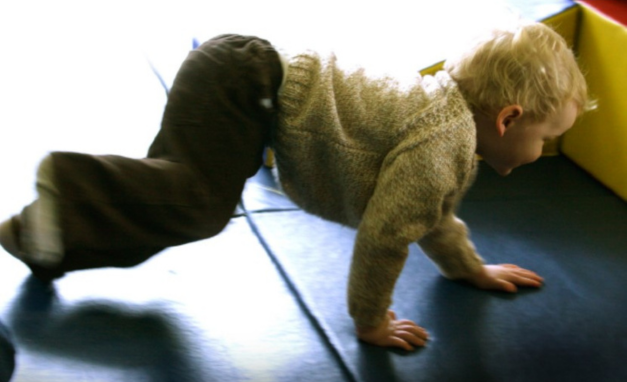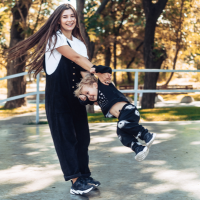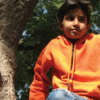Early years movement play

A guide for families and educators
This guide will encourage you to move with your child.
It will provide you with a glimpse of the theory and research underpinning movement play and tell you where to go to find out more.
What is movement play?
Movement begins before birth. Over the first few years of life we go from being at the mercy of reflex movement patterns designed for survival to the controlled movement patterns of adulthood. Children explore the world through movement, using it to investigate what they see, hear, smell, taste and touch. Through movement children learn about themselves and are able to communicate with others.
Movement play is what children naturally indulge in if adults provide them with enough space, time and encouragement. Movement play lays the foundations for all the movement patterns we need throughout life.
At its simplest, movement play covers the things children love to do when allowed to get on with their own exploration of the world. We witness it when we see babies putting toes in their mouths, when a toddler lies upside down on the sofa, whenever they roll, spin, wriggle, jump or climb. Movement allows children to discover how they relate to the world as well as how their bodies work; so we do need to encourage this.
Everything we do, everything we learn, requires us to control our movements. The hardest movement skill of all is staying still because this requires us to control every muscle in our bodies. A child starting school with good movement abilities will usually be able to access formal learning more easily than other children.
Fun on the floor and on the move
Fun on the floor
Babies need to spend time lying without restrictions of furniture or tight clothing and socks, on a flat surface such as the floor or a cot. Their skin, especially that of their hands and feet, acts as a sense organ feeling the world around them and helping them discover they are separate from it.
When babies play with their toes they are strengthening leg muscles and aligning their knee and hip joints for walking. When on their tummies babies need to push against gravity to raise their heads, strengthening neck muscles and bringing the head into line with the spinal column. Tummy time helps a child learn about sensations: when their bladder is full or empty, when they are warm or cold, when they are brushing up against another object or person.
All this is hard work and babies often complain by crying so we pick them up. This may, quite unintentionally, train them to desire being held rather than being content lying down. It is important to comfort your baby and gradually introduce tummy time. Some babies may prefer tummy time once they have arrived there independently.
Ways to encourage your baby to be happy on the floor
- Get down there with them, stroking them and singing songs, telling them about their body parts.
- Play games like ‘This little piggy’ or ‘Round and round the garden’.
- Hold toys out for them to reach up to and move them from side to side to encourage visual tracking.
- Encourage head turning by making a noise to one side and praising your child when it turns to look.
- Attach one end of a ribbon to a child’s foot or hand and the other to a cot mobile. When they move their limb the mobile will move. This helps a baby control one limb at a time and teaches them that movement has consequences. Such an activity must be supervised at all times for safety.
- If your child seems unhappy try to distract them before picking them up. Instead play a new game first, they may simply be bored. This sends out the message that playing lying down is important.
- Never leave your baby on the floor or in their cot if they are really distressed. Lots of 5 minute fun times on the floor are better than one long distressing 30 minutes where you force them to play.
- Make the most of times when a baby is naturally on a flat surface e.g. nappy changing or bath times. Take time over these activities and enjoy playing for a few minutes. Sing and tickle baby.
- Avoid leaving your child in a car seat or other restraining seat for long periods. These seats are designed to keep your child safe in particular circumstances. However, they provide too much support and do little to help your child develop and strengthen their muscles.
- Never leave babies on their stomachs unattended and always put a baby on their back to sleep. Until a child can confidently control their body to roll over they risk getting stuck on their front and may suffer breathing difficulties.
Fun on the move
As your baby becomes mobile encourage them to find out how their limbs move and what happens when their moving body comes into contact with a toy or another body etc. Avoid comparing your child with others, every child develops at their own pace.
Rolling
Rolling is usually a child’s first experience of moving independently and their first success at overcoming gravity. When a child rolls over they learn to adjust their weight, pulling it up away from the floor and letting it fall again. As a child learns to control their rolling they experience a degree of independence. For the first time in their life they can choose where to go and what and who to interact with.
Ways to encourage rolling
- Provide different surfaces and textures to roll on: carpet, rugs, duvet covers and grass.
- Place toys just out of reach so they must roll to get them.
- Roll around next to them on the floor or encourage them to roll to you for a cuddle.
- Wrap a child in a blanket and slowly unwind it, allowing the child to roll out of it.
Crawling and commando crawling
Crawling is important because it helps build neurological connections between the two halves of the brain enabling them to work more efficiently together.

Crawling strengthens the alignment of the head with the spine and completes the rotation of the legs in the hip joints, getting the child ready for walking. Crawling and commando crawling trains their eyes to track objects horizontally and vertically. These are vital skills for reading and writing.
All children are different and some go from sitting to walking, apparently bypassing this crucial stage. Don’t worry; children seem to instinctively know how important crawling is and how much they need to crawl in order to mature their primitive reflexes. Older children of 5 or 6 years often invent crawling games: being dogs or lions etc. Often the children who play these games most are the ones who missed out on crawling as babies. As adults we need to recognise the importance of crawling and provide opportunities for it.
We can encourage crawling by:
- Pretending to be animals.
- Playing ‘peek-a-boo’ behind the sofa and furniture.
- Inventing games like crawling through tunnels made by your own body, going under tables or in and out of cardboard boxes.
- Older children can play crawling tag games or practise being commandoes going round obstacle courses.
Spinning and off balance activities
Anyone who has spent time with young children knows that an irresistible urge to spin round until they get dizzy and fall over seems to overcome all children somewhere between the ages of 18 months to 3 years. Children need to spend time exploring what it is like to be in ‘not quite upright’ positions. Through experiencing such things as hanging upside down on a swing or rocking back and forth a toddler learns to defy gravity: to walk, run and dance.

Spinning serves several very important developmental needs. When a child stops spinning they must bring their focus back to one spot to prevent dizziness continuing for too long. This trains and strengthens the muscles that control the eyes and prepares them for reading and other activities where close attention to fine detail is needed. Spinning together with other activities where a child is not upright challenges the body’s sense of balance (the vestibular sense) and helps us to know which way up we are in relation to gravity. It is this sense of balance that allows us to walk, sit, run and dance without constantly having to check where our feet are.
We can encourage spinning and off balance activities by:
- Making sure children have enough space to spin without bumping into anything.
- Allow children to hang upside down off sofas or across swings etc.
- Invent games that challenge balance e.g. hopping, standing on one leg, walking along low walls, lying over a body ball, standing and looking through legs, walking on a line, jumping on or over the cracks in the pavement etc.
Jumping is connected to being off balance and children love jumping and skipping. Let them jump off the bottom step, off the furniture or on an old mattress in the garden; you don’t need to buy expensive trampolines.
Isn't all this crawling, jumping and spinning dangerous?
Learning how to assess and manage risk and scary situations is an important part of growing up.
Movement play helps children understand their own bodies, how far they can challenge themselves and in what circumstances it is safe to do so. Be mindful of calling out ‘be careful’ during an activity. This breaks a child’s concentration and at that moment they are more likely to slip and fall.
How can I encourage my child to manage risk?
- Talk to your child about risks before they encounter them – not in the middle of the activity.
- If your child is having difficulties help them by giving clear instructions. Tell them what to do with their body to get out of the situation themselves e.g. how to turn around and come down a ladder, how to look for the next safe foothold on a tree etc.
- Set boundaries e.g. you can only play in a particular area, or only go up to a certain point on a tree. Review these boundaries as the child gets older and involve them in the process.
- Talk more about what you want to see your child do rather than about what they are not allowed to do.
- Encourage your child to try new things, like going down a slide on their stomach, but never force them to do something they don’t want to do.
- Help them to understand that different people find different things challenging and that this is OK. Not everyone can climb a tree, not everyone feels safe swinging up high etc. Teach them from an early age to avoid peer pressure.
Top tips for promoting Movement Play
Five top tips: at home
- Lie your baby on their back on a soft mat and sing rhymes that involve counting fingers or toes.
- Lie your baby on their front and lie down next to them with a small toy in between you – talk to them and play with the toy encouraging them to look at it and reach out for it.
- When you are sitting on a chair you can support a child on your knees and play bouncing games, singing songs like ‘Horsey horsey’.
- As your child becomes more and more mobile allow them to climb all over you; you make the best and safest climbing frame. Tunnels and dens made from tables or clothes driers draped in sheets are great for crawling in.
- Buy an offcut of vinyl to put on your living room carpet. This makes a great surface for you and your child to spin round on your backside or slither along on your stomach.
Note: Whenever you are on the floor with your child make sure you look after yourself. Children under 5 years are designed to be on the floor, rolling, crawling and spinning but you are not. You may need to invest in some knee pads to allow you to spend time crawling around with your child.
When lying on your back always bend your knees as this protects your spine and train your child to sit across you over your hip joints and not across your stomach. Accept the fact that as your child grows they will become too heavy to lift. Prepare your child for the day when you can no longer play these games by explaining how you feel and providing boundaries e.g. three more lifts and that’s all. If children are trained to use you as a climbing frame in a safe way they will have a greater understanding of how far to go when playing rough and tumble games with peers when they are a little older.
Five top tips: in the Park
- Children need to play outside in all weathers; it is good for their all round development and health. Dress children in clothes that don’t matter if they get dirty, torn or wet.
- To avoid conflicts arising when it is time to leave the park set firm boundaries before you go. A phone or a kitchen timer can be very useful because you can agree on a time, say 20 minutes, and set the timer; when it rings you leave the park. Using a timer also helps your child understand and learn to estimate time.
- Allow your child to roll down grassy slopes – join in if you feel able. If you are worried that the slope may be unsafe for any reason e.g. broken glass, then train your child to wait at the top while you check it, then give them a signal to roll down and meet you.
- Swings are great for challenging the vestibular system, for practising being off balance and then returning to a balanced position. Children will swing higher and higher as they get bolder but as long as they are in control they will not go higher than they can cope with. They often like to drape themselves over a swing and look at the ground. If you are pushing them constantly check that they feel safe. Supervise infants on play equipment.

- Children from about three upwards like the challenge of climbing trees. Children will rarely climb higher than they can cope with but if you are worried set limits. Use ribbons to indicate the limits of a child’s climb. This is particularly useful if you have several children who like to copy each other. Each child can have a coloured ribbon so they can all climb the same tree, which makes it easier for you to keep an eye on them (if you have trees in your garden you can paint a line round them to indicate ‘no higher’).
Five top tips: out and about with your child
It is possible to interweave fun and games into the more mundane things of life like going shopping, standing in a queue or travelling in a car.
- A large pram gives your baby a flat surface to lie on and stretch out. In a large pram a child can sit up (it is best if they are strapped in to avoid falling over the side) and experience holding their body against gravity. Many modern pushchairs provide so much support there is little work for a baby’s own muscles to do. Resist the temptation to leave a child in a restraint like a pushchair or car seat for long periods of time. They may well be happy but they are not developing their muscles and subsequent areas of development.
- When your child is ready to be trusted to walk ahead of you independently, then you can introduce several travelling games. Suggest them to run to the next lamp post and see how many jumps they can do before you catch up with them. Or maybe how many times they can turn around or count how long they can stand on one leg. Jumping and standing on one leg challenges can be done to alleviate the boredom of queuing.
- In a safe space, allow your child to walk backwards, staying close to you, maybe holding your hand. Backwards walking is a different sensation from walking forwards and requires more concentration to maintain balance. Talk to them while they are doing this to help them develop their vocabulary.
- In the car sing action rhymes that can be done sitting e.g. the ‘Wheels on the Bus,’ ‘Wind the Bobbin Up’ or ‘Head, Shoulders, Knees and Toes’.
- Older children can combine a language game with a movement game which I call ‘When I get there I can....’ Give children a word, written on card if necessary, and get your child to collect the letters as they walk alongside you. There are letters all around us, on car number plates, shops, people’s T-shirts etc. The completed words can then be exchanged for a go on that piece of equipment when they get to the park or get home. You can adapt this game to play in the car.
Why is Movement Play important?
When a baby is born it has millions of neurons in the brain but only some of these are connected. It is rather like a new housing development separated from the local shops by an open space. People walk across the space to get to the shops and after a while some paths become well established and are used more and more. A similar thing happens in the brain; movements cause neural pathways to form. The more times a pathway is used the stronger the neural connection becomes until eventually it becomes permanent and is covered in a protective sheath of cells called myelin, this is fundamental to all aspects of learning.
The human brain is in two hemispheres connected by a bundle of nerve fibres (corpus callosum) and movements that cross the mid-line of the body help to create pathways through this bundle. Skills such as reading, writing and problem solving rely on the two hemispheres working well together.
Will my child's nursery or pre-school cover movement play?
All early years’ settings follow the Early Years Foundation Stage Statutory Framework, this combines both gross and fine motor movement as well as expressive arts and design.
Movement play is implicit in the non-statutory guidance of Birth to 5 Matters and Developmental Matters. Where families support children in such play noticeable advances will take place in your child’s developmental journey and not just in movement, but in other subsequent areas of learning.
If you would like more support in Movement Play speak to your child’s educator or visit the resources section below.
Conclusion
Everything we learn to do from walking and talking to driving a car or wiring up a plug relies on our ability to control our movements. During our first few years of life we lay down the movement patterns that will be crucial for all the learning we do as adolescents and adults.
As adults our role is to make sure children get lots of opportunities to explore movement and practise movement skills. We need to keep them safe while they do this and train them to assess risks for themselves so they can keep themselves safe when we are not around.
In our safety conscious society it is all too easy for children to spend a lot of time in small rooms engaged in pursuits on screens. Children need space; they need to face challenge and risk within acceptable limits in order to fully develop both their bodies and their minds. They need adults who will allow them to explore the world through movement and enjoy that movement with them.
Useful resources: books and video
- Battelley, H. (2021) 50 Fantastic Ideas Songs Rhymes
- Dr Lala Manners (2019) Early Years Movement Handbook published by Jessica Kingsley Publishers ISBN 1785922602
- O’Connor, A. and Daly,A.(2016)Understanding Physical Development in Early Years published by Routledge ISBN 0415722483
- Early Movers is a comprehensive list and video of activities to support children in Movement Play
- Jabadao Video links
- A selection of videos and activities to support music and movement - Early Years
- A FREE online course by the Open University: Supporting physical development in early childhood.
- If you would like to further your learning the Department for Education has created a course on physical development
Useful Contacts
- Jabadao
- The Istitute for Neuro-Physiological Psychology Research
- Brain Gym
- Sherborne Association
- Active Matters
- Birth to 5 Matters
- Development Matters (Gov.uk)
- Early Years Foundation Stage
- Cherwell District Council - email: wellbeing@cherwell-dc.gov.uk or telephone 01295 221980
Movement Play booklet
This booklet was written by Sue Ayliff in collaboration with Paula Bailey and Deborah Alexander with photos by Cathy Hattam.
The first edition was produced in 2008 and second edition in 2024 by Cherwell District Council.
The authors wish to thank Helen Battelley for her valued contribution to the second edition revisions (2024) and all parents, children and educators who have attended workshops and inspired this booklet.

